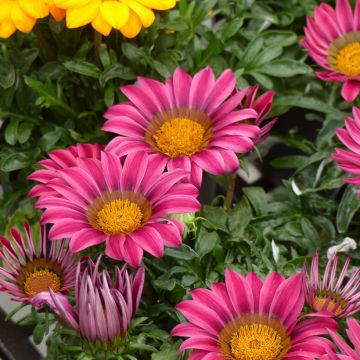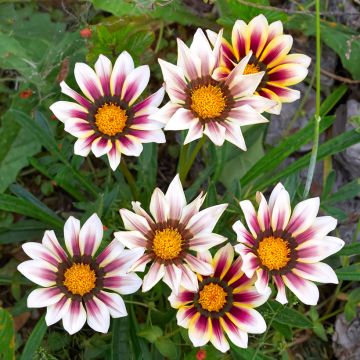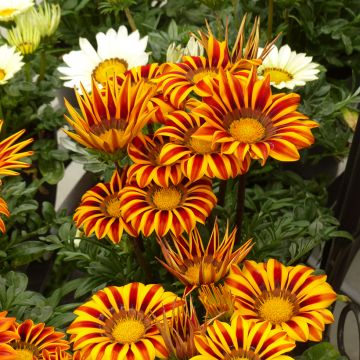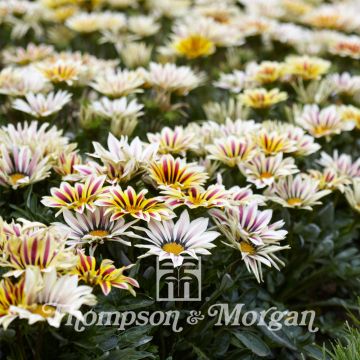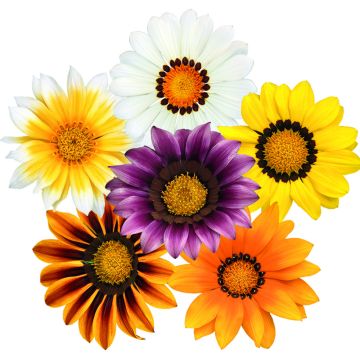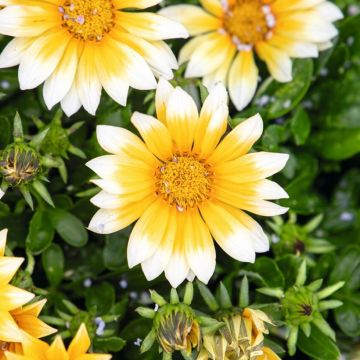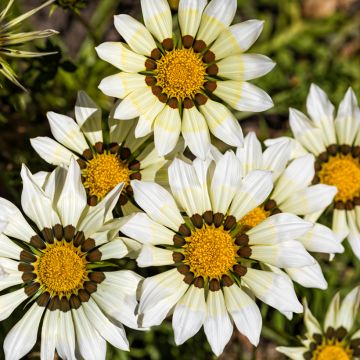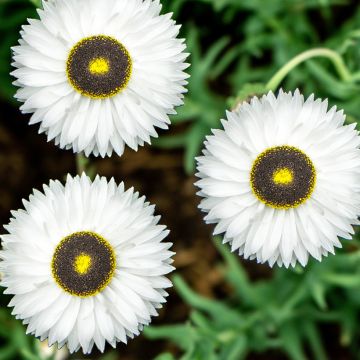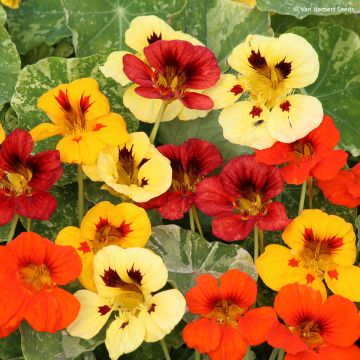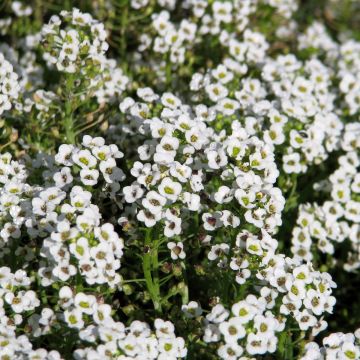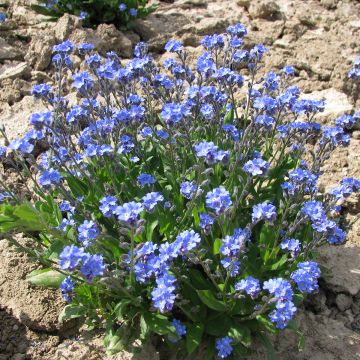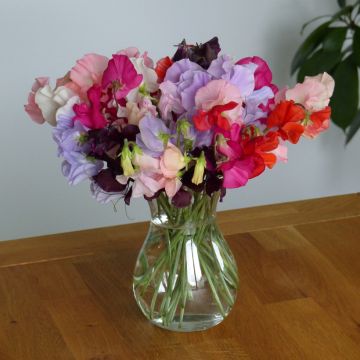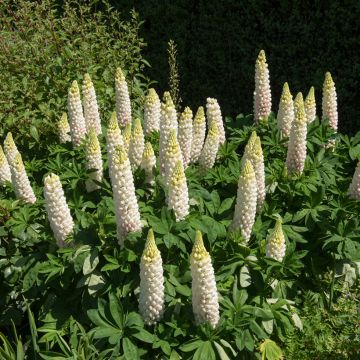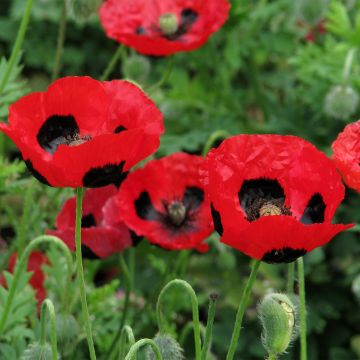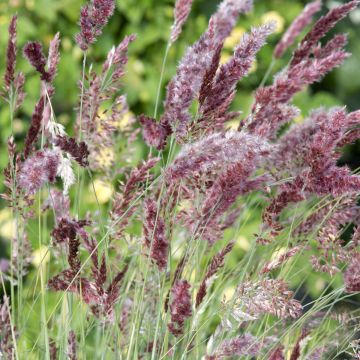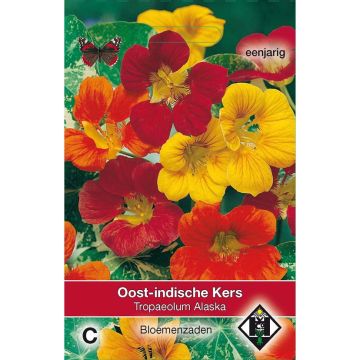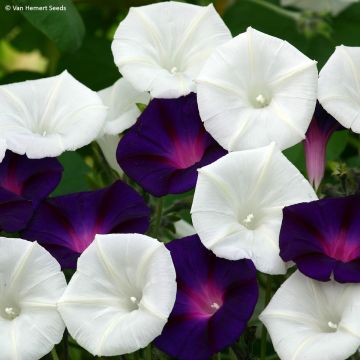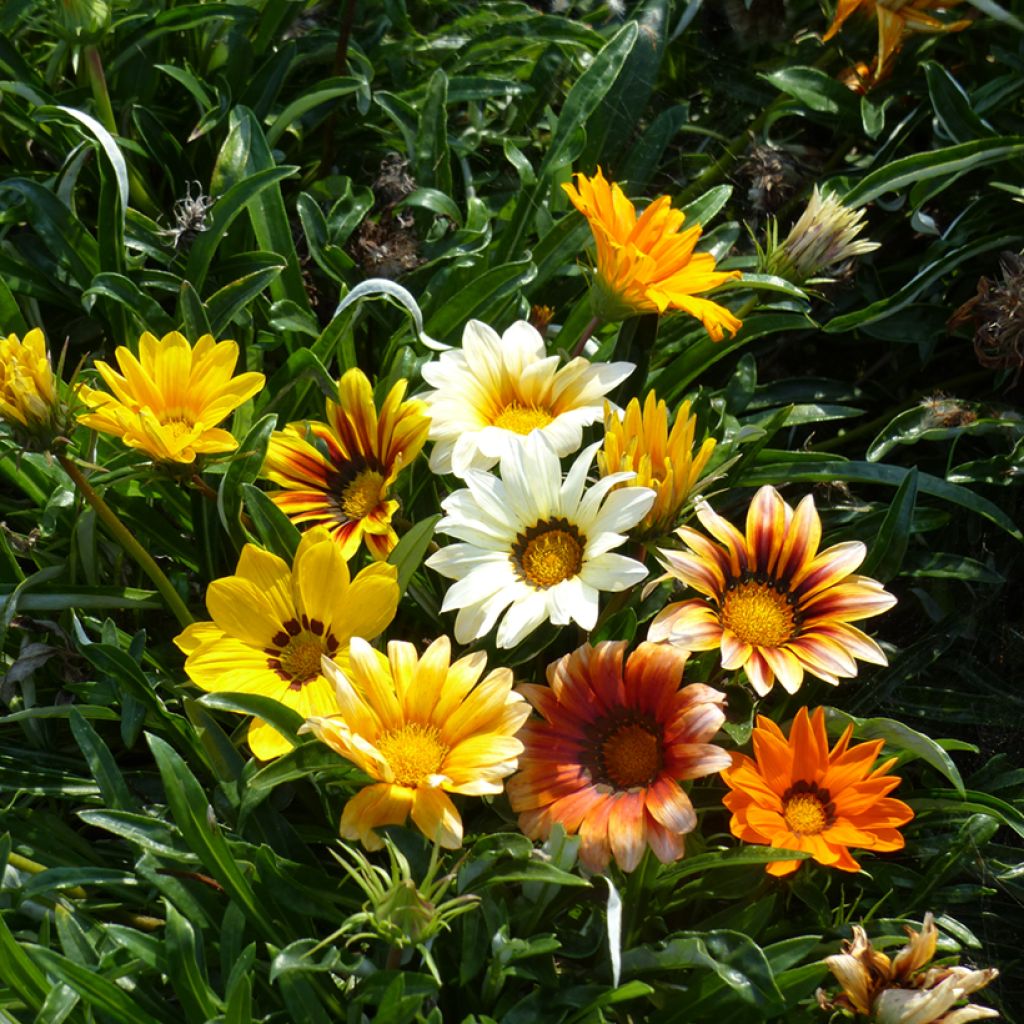

Gazania (x) splendens Sunshine Hybrids
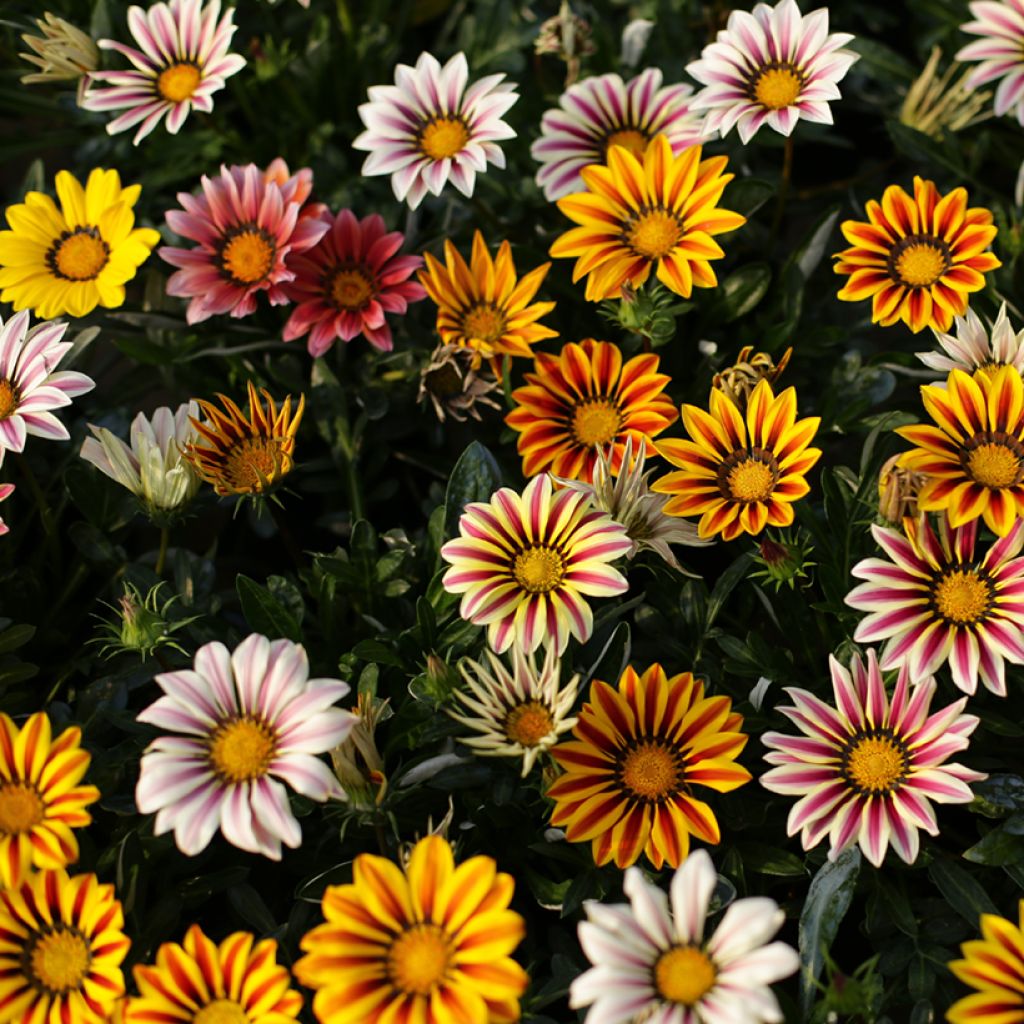

Gazania (x) splendens Sunshine Hybrids
Gazania (x) splendens Sunshine Hybrids
Gazania (x) splendens Sunshine Hybrids
This item cannot be shipped to the selected country
Dispatch by letter from €3.90
More information
Schedule delivery date,
and select date in basket
This plant carries a 6 months recovery warranty
More information
We guarantee the quality of our plants for a full growing cycle, and will replace at our expense any plant that fails to recover under normal climatic and planting conditions.
Seed-only orders are dispatched by sealed envelope. The delivery charge for seed-only orders is €3.90.
Does this plant fit my garden?
Set up your Plantfit profile →
Description
The 'Sunshine Hybrids' Gazania is a variety of flamboyant colours. The large flowers, measuring 7 to 10 cm in diameter, havel an exotic appearance and come in bright orange, bright yellow, white streaked with pink, and yellow streaked with red. The plant, although not very hardy, is very compact and highly floriferous, even in hot and dry conditions. From spring to the first frost, it brings life to sunny borders and containers. Outside Mediterranean regions, Gazania is grown as an annual plant.
Gazania, also known as Treasure Flower, is an Asteraceae plant with a daisy-like silhouette found throughout tropical Africa. It is a perennial cultivated as an annual in Europe. The 'Sunshine Hybrids' Gazania is a compact cultivar that forms a small clump of leafy stems measuring no more than 20 cm in all directions within a few weeks. The early and prolonged flowering period lasts from May to October if faded flowers are regularly removed. At the end of the branched stems, solitary inflorescences resembling large daisies, measuring 7 to 10 cm in diameter, form. Each one has a double row of outer ligules positioned in a staggered pattern. This collar of outer florets surrounds a centre composed of tubular central florets, giving it a velvety appearance. The flowers tend to close when the sun goes down. The basal leaves of the 'Sunshine Hybrids' Gazania are oval, leathery, fairly dark green and glossy on the upper side, and silver-grey on the underside.
Sow the 'Sunshine Hybrids' Gazania under shelter in late winter and spring, before planting them in small clusters in the borders of flower beds, combined with more subdued-coloured plants. Plant them in full sun, in the warmest spot in the garden, in well-drained soil, preferably sandy and dry. They do not tolerate stagnant moisture, but if you water them sparingly and regularly, they will be even more beautiful. They thrive in rock gardens and on slopes, as well as in raised beds. Their compact size also makes them suitable for planting in containers or pots, under a veranda or in a patio.
Report an error about the product description
Flowering
Foliage
Plant habit
Botanical data
Gazania
(x) splendens
Sunshine Hybrids
Asteraceae
Cultivar or hybrid
Other Gazania seeds
Planting and care
Sow Gazania seeds, which you will have previously soaked for a few hours, under glass from February to April. Bury them under 3mm of a mixture of potting soil and sand. Keep them in a warm place, ideally at a temperature ranging from 18 to 25°C. Keep the soil slightly moist without excess. You will have to wait 14 to 30 days to see the young seedlings appear. When they are large enough to handle, transplant them into pots where you will acclimatise them for about ten days. After that, you can plant them in the ground when the last frost is no longer a concern. Be sure to space each plant 20 to 30 cm apart.
Cultivation: in full sun, in ordinary but well-drained soil, possibly lightened with gravel, sand, and potting soil. Gazanias dislike stagnant moisture, so avoid leaving water-filled saucers under the pots. A special fertiliser for flowering plants will be appreciated.
Sowing period
Intended location
This item has not been reviewed yet - be the first to leave a review about it.
Flower seeds
Haven't found what you were looking for?
Hardiness is the lowest winter temperature a plant can endure without suffering serious damage or even dying. However, hardiness is affected by location (a sheltered area, such as a patio), protection (winter cover) and soil type (hardiness is improved by well-drained soil).

Photo Sharing Terms & Conditions
In order to encourage gardeners to interact and share their experiences, Promesse de fleurs offers various media enabling content to be uploaded onto its Site - in particular via the ‘Photo sharing’ module.
The User agrees to refrain from:
- Posting any content that is illegal, prejudicial, insulting, racist, inciteful to hatred, revisionist, contrary to public decency, that infringes on privacy or on the privacy rights of third parties, in particular the publicity rights of persons and goods, intellectual property rights, or the right to privacy.
- Submitting content on behalf of a third party;
- Impersonate the identity of a third party and/or publish any personal information about a third party;
In general, the User undertakes to refrain from any unethical behaviour.
All Content (in particular text, comments, files, images, photos, videos, creative works, etc.), which may be subject to property or intellectual property rights, image or other private rights, shall remain the property of the User, subject to the limited rights granted by the terms of the licence granted by Promesse de fleurs as stated below. Users are at liberty to publish or not to publish such Content on the Site, notably via the ‘Photo Sharing’ facility, and accept that this Content shall be made public and freely accessible, notably on the Internet.
Users further acknowledge, undertake to have ,and guarantee that they hold all necessary rights and permissions to publish such material on the Site, in particular with regard to the legislation in force pertaining to any privacy, property, intellectual property, image, or contractual rights, or rights of any other nature. By publishing such Content on the Site, Users acknowledge accepting full liability as publishers of the Content within the meaning of the law, and grant Promesse de fleurs, free of charge, an inclusive, worldwide licence for the said Content for the entire duration of its publication, including all reproduction, representation, up/downloading, displaying, performing, transmission, and storage rights.
Users also grant permission for their name to be linked to the Content and accept that this link may not always be made available.
By engaging in posting material, Users consent to their Content becoming automatically accessible on the Internet, in particular on other sites and/or blogs and/or web pages of the Promesse de fleurs site, including in particular social pages and the Promesse de fleurs catalogue.
Users may secure the removal of entrusted content free of charge by issuing a simple request via our contact form.
The flowering period indicated on our website applies to countries and regions located in USDA zone 8 (France, the United Kingdom, Ireland, the Netherlands, etc.)
It will vary according to where you live:
- In zones 9 to 10 (Italy, Spain, Greece, etc.), flowering will occur about 2 to 4 weeks earlier.
- In zones 6 to 7 (Germany, Poland, Slovenia, and lower mountainous regions), flowering will be delayed by 2 to 3 weeks.
- In zone 5 (Central Europe, Scandinavia), blooming will be delayed by 3 to 5 weeks.
In temperate climates, pruning of spring-flowering shrubs (forsythia, spireas, etc.) should be done just after flowering.
Pruning of summer-flowering shrubs (Indian Lilac, Perovskia, etc.) can be done in winter or spring.
In cold regions as well as with frost-sensitive plants, avoid pruning too early when severe frosts may still occur.
The planting period indicated on our website applies to countries and regions located in USDA zone 8 (France, United Kingdom, Ireland, Netherlands).
It will vary according to where you live:
- In Mediterranean zones (Marseille, Madrid, Milan, etc.), autumn and winter are the best planting periods.
- In continental zones (Strasbourg, Munich, Vienna, etc.), delay planting by 2 to 3 weeks in spring and bring it forward by 2 to 4 weeks in autumn.
- In mountainous regions (the Alps, Pyrenees, Carpathians, etc.), it is best to plant in late spring (May-June) or late summer (August-September).
The harvesting period indicated on our website applies to countries and regions in USDA zone 8 (France, England, Ireland, the Netherlands).
In colder areas (Scandinavia, Poland, Austria...) fruit and vegetable harvests are likely to be delayed by 3-4 weeks.
In warmer areas (Italy, Spain, Greece, etc.), harvesting will probably take place earlier, depending on weather conditions.
The sowing periods indicated on our website apply to countries and regions within USDA Zone 8 (France, UK, Ireland, Netherlands).
In colder areas (Scandinavia, Poland, Austria...), delay any outdoor sowing by 3-4 weeks, or sow under glass.
In warmer climes (Italy, Spain, Greece, etc.), bring outdoor sowing forward by a few weeks.

































